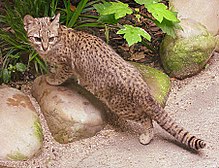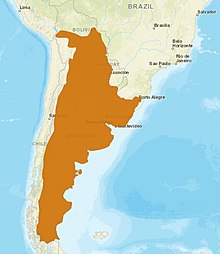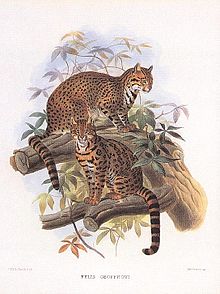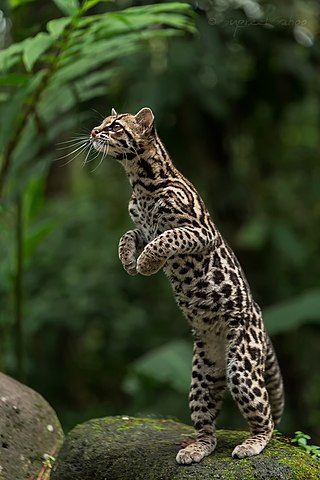
The margay is a small wild cat native to Central and South America. A solitary and nocturnal felid, it lives mainly in primary evergreen and deciduous forest.

The ocelot is a medium-sized spotted wild cat that reaches 40–50 cm (15.7–19.7 in) at the shoulders and weighs between 7 and 15.5 kg on average. It is native to the southwestern United States, Mexico, Central and South America, and the Caribbean islands of Trinidad and Margarita. Carl Linnaeus scientifically described it in 1758. Two subspecies are recognized.

The wildcat is a species complex comprising two small wild cat species: the European wildcat and the African wildcat. The European wildcat inhabits forests in Europe, Anatolia and the Caucasus, while the African wildcat inhabits semi-arid landscapes and steppes in Africa, the Arabian Peninsula, Central Asia, into western India and western China. The wildcat species differ in fur pattern, tail, and size: the European wildcat has long fur and a bushy tail with a rounded tip; the smaller African wildcat is more faintly striped, has short sandy-gray fur and a tapering tail; the Asiatic wildcat is spotted.
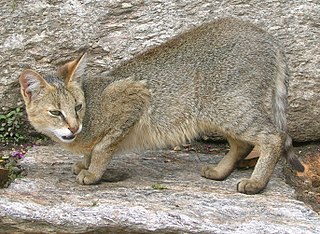
The jungle cat, also called reed cat, swamp cat and jungle lynx, is a medium-sized cat native to the Middle East, the Caucasus, South and Southeast Asia and southern China. It inhabits foremost wetlands like swamps, littoral and riparian areas with dense vegetation. It is listed as Least Concern on the IUCN Red List, and is mainly threatened by destruction of wetlands, trapping and poisoning.
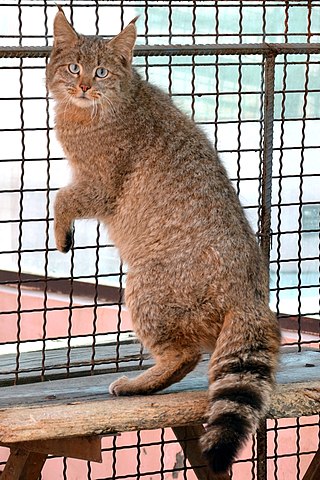
The Chinese mountain cat, also known as Chinese desert cat and Chinese steppe cat, is a small wild Felis species with sand-coloured fur, faint dark stripes on the face and legs and black tipped ears. It is endemic to the Tibetan Plateau of western China, where it lives in grassland above elevations of 2,500 m (8,200 ft). It has been listed as vulnerable on the IUCN Red List since 2002.

The African golden cat is a wild cat endemic to the rainforests of West and Central Africa. It is threatened due to deforestation and bushmeat hunting and listed as Vulnerable on the IUCN Red List. It is a close relative of both the caracal and the serval. Previously, it was placed in the genus Profelis. Its body size ranges from 61 to 101 cm with a 16 to 46 cm long tail.

The serval is a wild cat native to Africa. It is widespread in sub-Saharan countries, except rainforest regions. Across its range, it occurs in protected areas, and hunting it is either prohibited or regulated in range countries.

The rusty-spotted cat is one of the cat family's smallest members, of which historical records are known only from India and Sri Lanka. In 2012, it was also recorded in the western Terai of Nepal. Since 2016, the global wild population is listed as Near Threatened on the IUCN Red List as it is fragmented and affected by loss and destruction of its prime habitat, deciduous forests.

The oncilla, also known as the northern tiger cat, little spotted cat, and tigrillo, is a small spotted cat ranging from Central America to central Brazil. It is listed as Vulnerable on the IUCN Red List, and the population is threatened by deforestation and conversion of habitat to agricultural land.
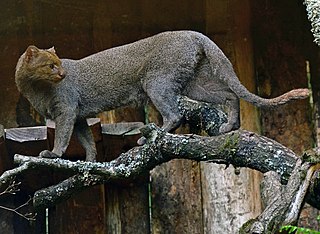
The jaguarundi is a wild cat native to the Americas. Its range extends from central Argentina in the south to northern Mexico, through Central and South America east of the Andes. The jaguarundi is a medium-sized cat of slender build. Its coloration is uniform with two color morphs, gray and red. It has an elongated body, with relatively short legs, a small, narrow head, small, round ears, a short snout, and a long tail, resembling mustelids in these respects. It is about twice as large as a domestic cat, reaching nearly 360 mm (14 in) at the shoulder, and weighs 3.5–7 kg (7.7–15.4 lb).
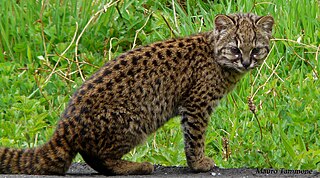
The kodkod, also called güiña, is the smallest felid species native to the Americas. It lives primarily in central and southern Chile, as well as marginally in adjoining areas of Argentina. Since 2002, it has been listed as Vulnerable on the IUCN Red List as the total population may be less than 10,000 mature individuals; it is threatened by persecution, and loss of habitat and prey base.

Prionailurus is a genus of spotted, small wild cats native to Asia. Forests are their preferred habitat; they feed on small mammals, reptiles and birds, and occasionally aquatic wildlife.
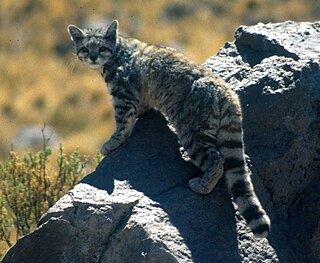
The Andean mountain cat is a small wild cat native to the high Andes that has been listed as Endangered on the IUCN Red List because fewer than 1,500 individuals are thought to exist in the wild. It is traditionally considered a sacred animal by indigenous Aymara and Quechua people.
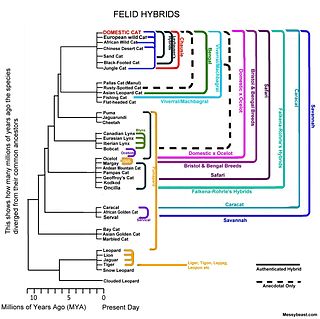
A felid hybrid is any of a number of hybrids between various species of the cat family, Felidae. This article deals with hybrids between the species of the subfamily Felinae.

Leopardus is a genus comprising eight species of small cats native to the Americas. This genus is considered the oldest branch of a genetic lineage of small cats in the Americas whose common ancestor crossed the Bering land bridge from Asia to North America in the late Miocene.

The Pampas cat is a small wild cat native to South America. It is listed as Near Threatened on the IUCN Red List as habitat conversion and destruction may cause the population to decline in the future.
The Pantanal cat is a Pampas cat subspecies, a small wild cat native to South America. It is named after the Pantanal wetlands in central South America, where it inhabits mainly grassland, shrubland, savannas and deciduous forests.

The Andean Cat Alliance is a network of researchers and conservationists working to study and protect the Andean cat and its habitat in Argentina, Bolivia, Chile and Peru. It is partnered with the Wildlife Conservation Network, and has developed a strategic plan for conservation of the species.

Leopardus guttulus, the southern tigrina or southern tiger cat, is a small wild cat species native to Brazil, Argentina and Paraguay.
